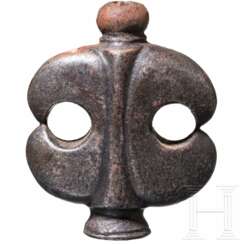2446 Items by auctions and galleries:
gens
Lot 264 Christian Ernst Bernhard Morgenstern
Christian Ernst Bernhard Morgenstern (1805 - 1867)  A419: Kunst und Antiquitäten Winter 2025
A419: Kunst und Antiquitäten Winter 2025 

Christian Ernst Bernhard Morgenstern
29.09.1805 - 26.02.1867
Germany
Christian Ernst Bernhard Morgenstern was a well-known German landscape painter. He is considered one of the most important representatives of early painterly realism.
His father was Hamburg miniature painter Johann Heinrich Morgenstern, and his son named Carl Ernst Morgenstern also became a landscape painter.

Kunstauktionshaus Neumeister
A419: Kunst und Antiquitäten Winter 2025
Date: 03.12.2025 14:00 UTC +01:00
Number of lots in the catalog: 356
Lot 829 Großherzogtum Hessen, Ehrensäbel des August Prinz zu Sayn-Wittgenstein-Berleburg aus dem Jahr 1828 - hessisch-nassauischer General, Staatsminister und Reichskriegsminister.
Grosse Militaria Winterauktion 2025 Teil 2 

Landshuter Rüstkammer GmbH & Co.KG
Grosse Militaria Winterauktion 2025 Teil 2
Date: 29.03.2025 11:30 UTC +01:00
Number of lots in the catalog: 736
Lot 621 Österreich-Ungarn, Schautafel mit Kragenspiegel und Tätigkeitsabzeichen K.u.k. Heer - Beleuchtungsscheinwerfer Abteilung.
Grosse Militaria Winterauktion 2025 

Landshuter Rüstkammer GmbH & Co.KG
Grosse Militaria Winterauktion 2025
Date: 28.03.2025 11:30 UTC +01:00
Number of lots in the catalog: 669
Lot 622 Österreich-Ungarn, Schautafel mit Kragenspiegel und Tätigkeitsabzeichen K.u.k. Heer - Eisenbahn- und Telegrafenregiment.
Grosse Militaria Winterauktion 2025 

Landshuter Rüstkammer GmbH & Co.KG
Grosse Militaria Winterauktion 2025
Date: 28.03.2025 11:30 UTC +01:00
Number of lots in the catalog: 669
Lot 623 Österreich-Ungarn, Schautafel mit Kragenspiegel und Tätigkeitsabzeichen K.u.k. Heer - Elektromaschineller Dienst, Elektro-Ersatzabteilung.
Grosse Militaria Winterauktion 2025 

Landshuter Rüstkammer GmbH & Co.KG
Grosse Militaria Winterauktion 2025
Date: 28.03.2025 11:30 UTC +01:00
Number of lots in the catalog: 669
Lot 624 Österreich-Ungarn, Schautafel mit Kragenspiegel und Tätigkeitsabzeichen K.u.k. Heer - Kraftfahrtruppe, Automobilabteilung, Radfahrerkompanie.
Grosse Militaria Winterauktion 2025 

Landshuter Rüstkammer GmbH & Co.KG
Grosse Militaria Winterauktion 2025
Date: 28.03.2025 11:30 UTC +01:00
Number of lots in the catalog: 669
Lot 625 Österreich-Ungarn, Schautafel mit Kragenspiegel und Tätigkeitsabzeichen K.u.k. Heer - Telegrafenregiment, Feldtelegrafenabteilung.
Grosse Militaria Winterauktion 2025 

Landshuter Rüstkammer GmbH & Co.KG
Grosse Militaria Winterauktion 2025
Date: 28.03.2025 11:30 UTC +01:00
Number of lots in the catalog: 669


































































